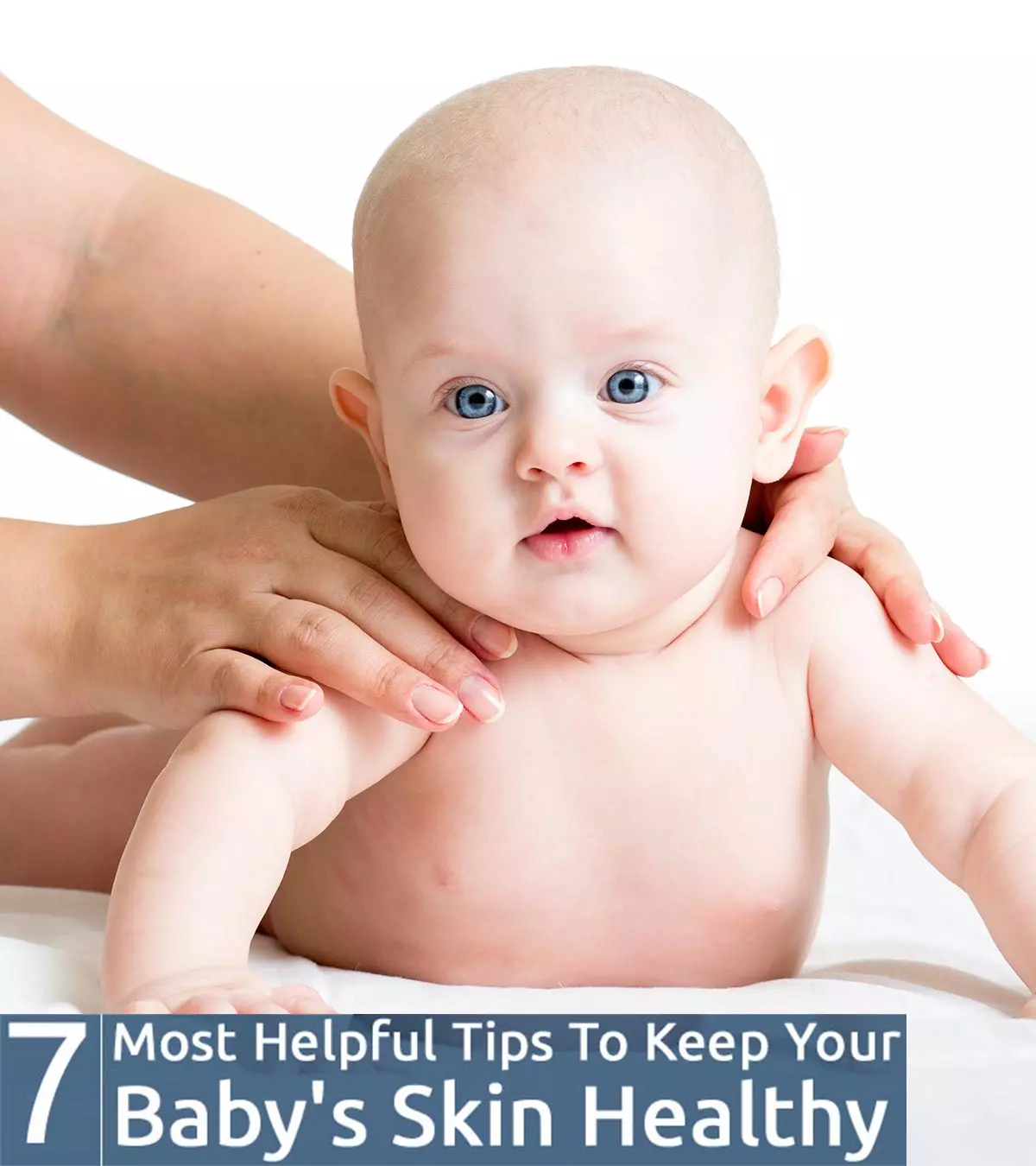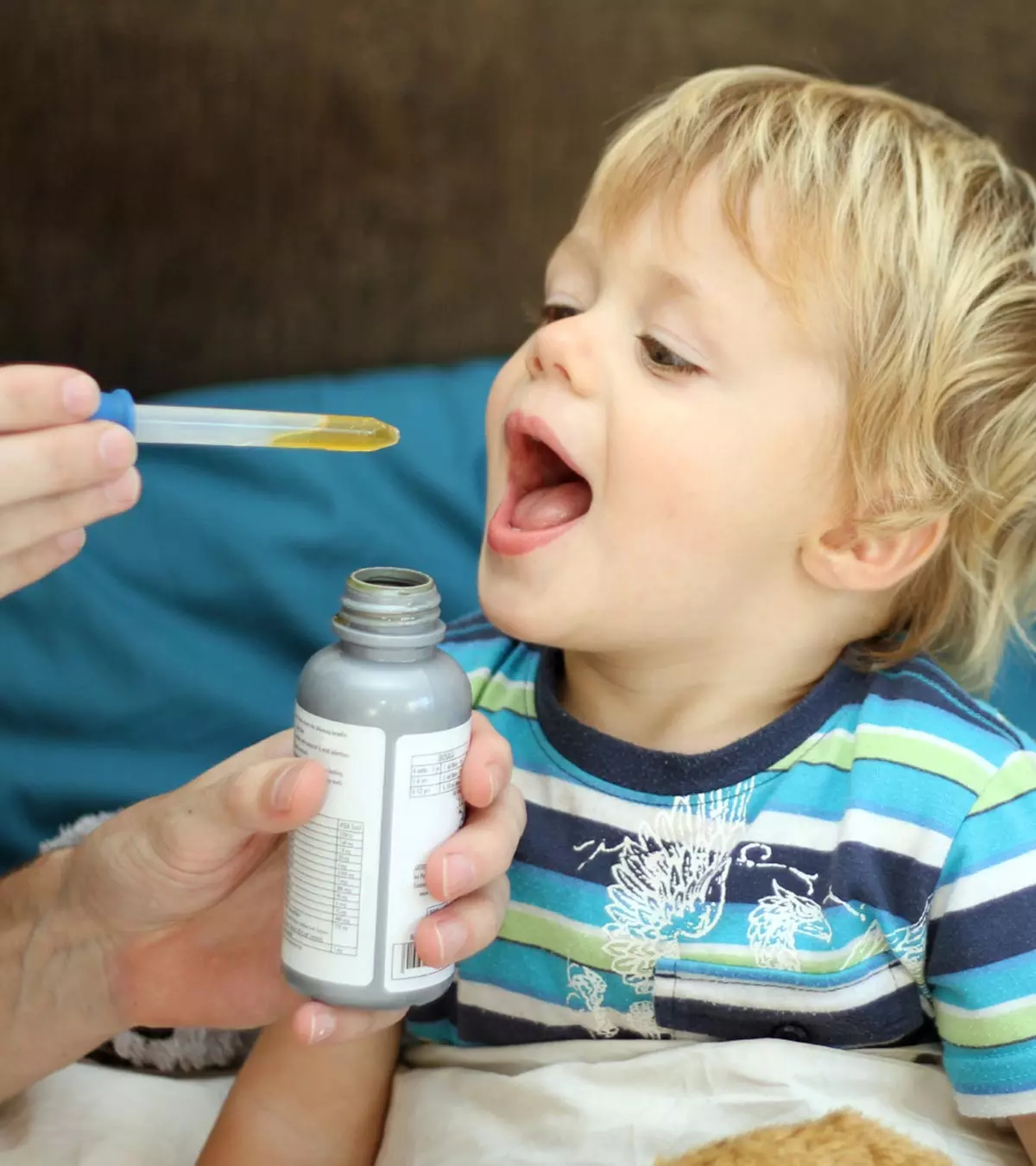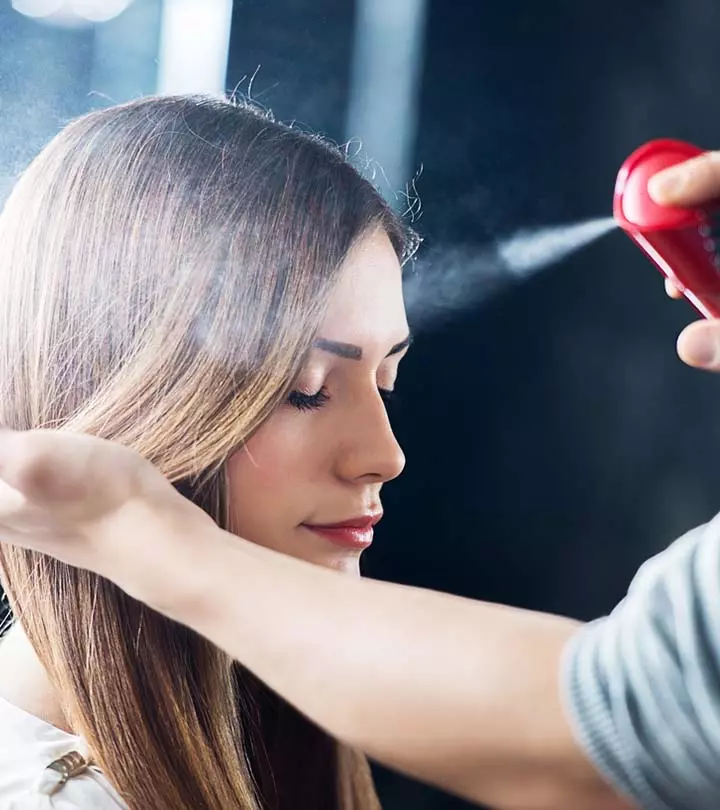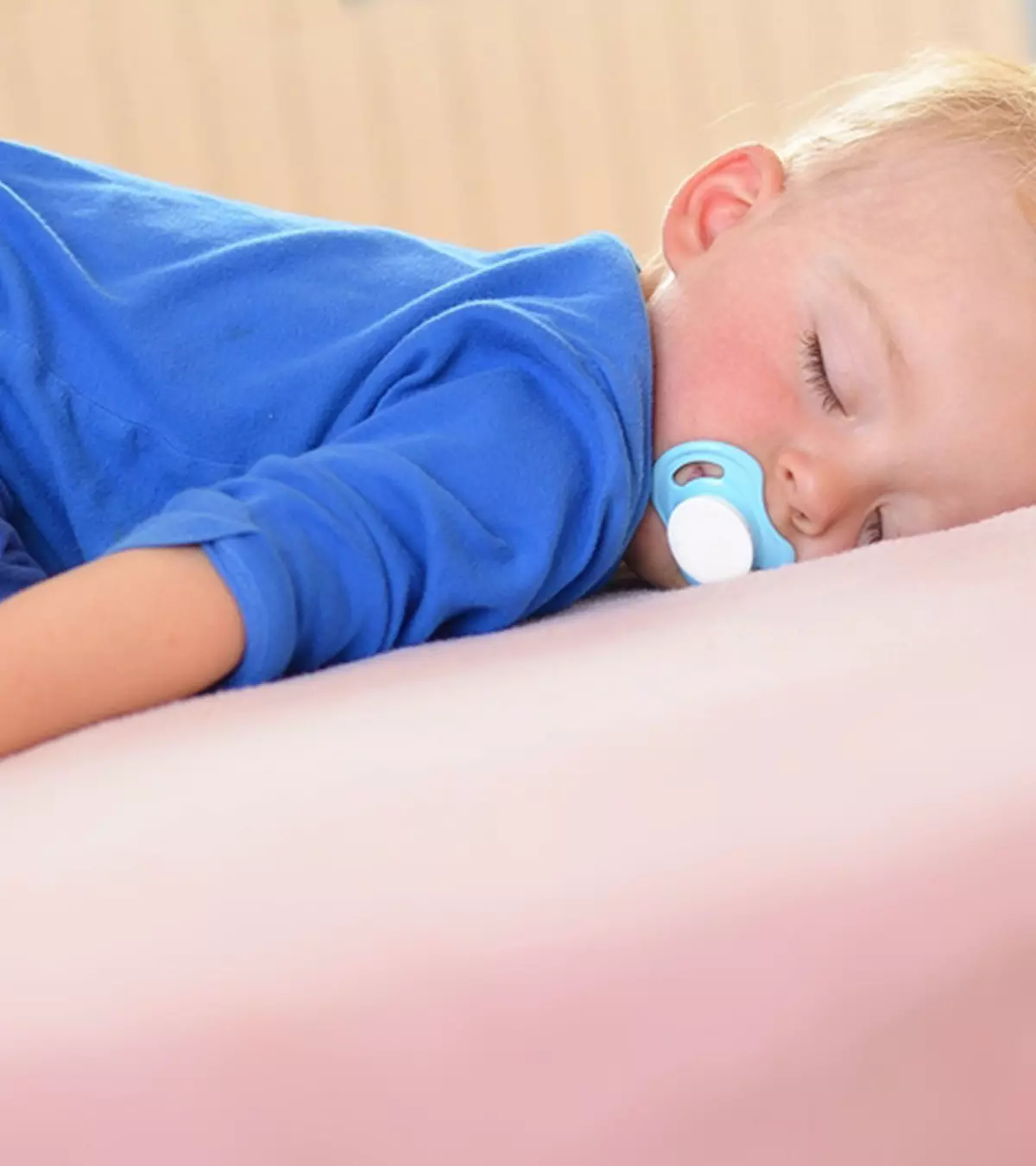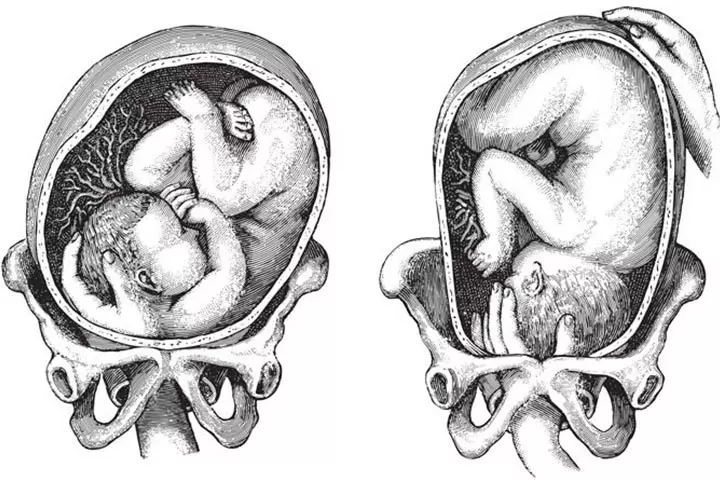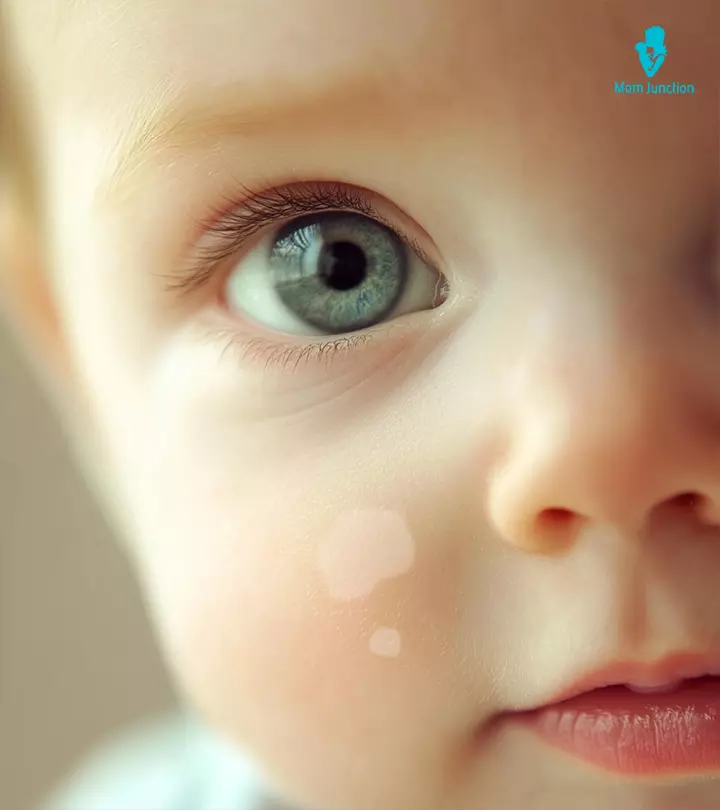
Image: Midjourney/ MomJunction Design Team
The exact causes of vitiligo in children are not known. This chronic condition causes loss of skin pigment (melanin), resulting in white patches in the skin. Hair and oral cavity may also have discoloration. These long-lasting patches can cause psychosocial issues in some children, especially teenagers. Adequate awareness and support from parents are essential to overcome low-self esteem issues (1). A joint research conducted by scientists from the United States and France demonstrated that around 1.52% of children and 2.16% of teenagers in the US had vitiligo (19). However, vitiligo is not contagious and it does not spread from one person to another. The condition does not affect children’s intelligence and other skills and abilities. Read on to learn more about the causes, types, and ways to manage vitiligo in kids.

Key Pointers
- Vitiligo in children may be caused by the loss of melanin-producing cells, although its exact cause is uncertain.
- A doctor can diagnose vitiligo in children through a Wood’s lamp examination, visual inspection, and by asking about their medical and family history from their parents.
- Treatment for vitiligo in children may involve one or more methods, such as using topical steroids, calcineurin inhibitors, or vitamin D.
- Children with vitiligo may face challenges with poor self-esteem, and thus require adequate parental understanding and encouragement to help overcome these challenges.
What Causes Vitiligo In Children?
Nonfunctioning or death of melanin-producing cells results in the loss of skin pigmentation in the body. Melanin is a pigment produced by cells called melanocytes. The exact cause for melanocyte dysfunction is yet to be discovered. It can be due to:
- Heredity: Vitiligo may be passed on from parents or family members to the child. Studies indicate that children with the condition may lack or have insufficient quantities of a key enzyme called tyrosinase, which helps produce melanin in cells. However, further studies are being done to determine other genetic causes behind vitiligo.

- Autoimmunity: A theory suggests that vitiligo is caused when the immune system destroys melanocytes in the body, mistaking them for bacterial infections. The theory also suggests that the immune reaction may be triggered when free radicals built up under the skin damage the melanocytes (20).
- Environmental factors such as sunburn, stress, and exposure to chemicals can cause vitiligo (2). Studies indicate that ultraviolet radiation tends to trigger the production of reactive oxygen species (ROS), which damage or kill melanocytes, leading to white patches. It is assumed that a similar reaction is produced by stress and chemical exposure (20).
- Other medical conditions such as pernicious anemia, rheumatoid arthritis, alopecia, and systemic lupus erythematosus have also been reported to cause white patches due to melanocyte death in certain parts of the body (5) (21).
Vitiligo, a skin condition, is non-contagious, which means a child cannot catch the disease from someone.
 Point to consider
Point to considerWhat Are The Symptoms Of Vitiligo In Children?
The depigmented patches of skin are the primary symptom of vitiligo. It can affect any area of the body, particularly the areas exposed to sun. The spots can be of different sizes. The following are the symptoms of vitiligo:
- Loss of skin pigmentation in patches
- Premature whitening or graying of hair on the head, eyebrows, and eyelashes
- HypopigmentationiIt occurs when there is a low amount of melanin in the skin, making them lighter in comparison to unaffected parts in the oral and nasal cavity
- Changes in the color of the inner layer of the eye (retina)
- Low self-image due to concerns about appearance
- Inflammation in the ear
- Swelling in the retina or iris
Apart from these symptoms, vitiligo also increases the skin sensitivity for recurrent sunburns and predisposition to autoimmune conditions.
What Are The Various Types Of Vitiligo?
Vitiligo is classified into two different types and three subtypes (3) (4).
1. Nonsegmental vitiligo
Nonsegmental vitiligo is the most common form and characterized by the appearance of white patches on both sides of the body. It is also known as bilateral vitiligo, vitiligo vulgaris, and generalized vitiligo.
The color changes on the skin, usually starting from hands, around eyes or mouth, and on the feet. In a few cases, it begins from areas where the skin rubs frequently. You may notice the color loss is more noticeable and spreading to more body parts over time in nonsegmental vitiligo.
2. Segmental vitiligo
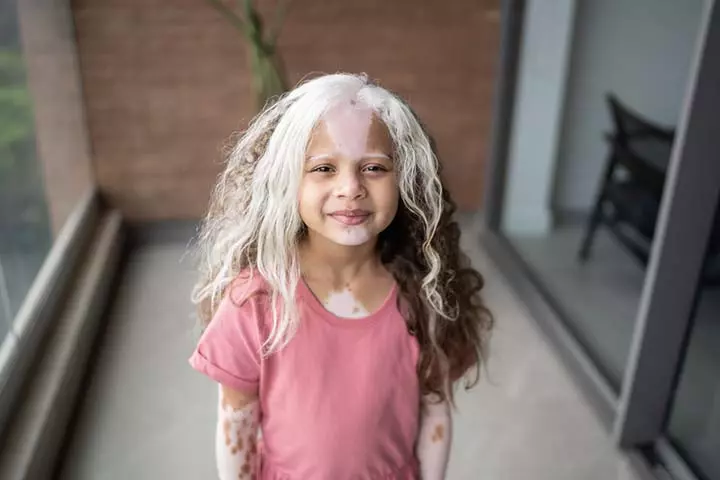
Segmental vitiligo is also called unilateral vitiligo. It usually starts at a younger age, when compared to nonsegmental vitiligo. It can involve a segment of the body, such as one leg or arm. 50% of cases are associated with color changes of hair, eyebrows, or eyelashes – a condition called poliosis (4).
Experts subtype vitiligo into three groups based on the loss of pigment on the body:
Localized: It is characterized by one or a couple of spots on the body. You might notice a loss of skin color on mucous membranes, known as mucosal vitiligoiA form of vitiligo where depigmentation occurs within the insides of the mouth, lips, nose, and genitalia , or in areas like the face and hands, known as acrofacial vitiligo (5) (6).
Generalized: The depigmentation appears on several areas of the body.
Universal: Major parts of the original skin color become patches. It is a rare form of vitiligo.
In addition to these two types mentioned, your child may also have vitiligo which can be classified into the following clinical variants:
- Trichrome vitiligo is recognized by its appearance, characterized into three sections. The affected area exhibits white spots with three distinct colors: a central zone of white depigmentation, the surrounding normal skin color, and a lighter region of skin in between, referred to as hypopigmented. This form of vitiligo indicates an active and progressive condition, necessitating prompt treatment (7).
- Quadrichrome vitiligo shows macular perifollicular (around the hair follicle) or marginal hyperpigmentationiA condition where a patch of skin is particularly darker than the areas surrounding it , in addition to symptoms associated with trichrome vitiligo. Notably, a fourth color (dark brown) appears in areas of perifollicular repigmentation, particularly in individuals with darker skin tones (8).
 Quick fact
Quick factHow To Diagnose Vitiligo In Infants And Children?
A doctor or dermatologist can diagnose the condition by visual examination of the white patches of the skin. They will use a specialized lamp called Wood’s lampiA source of long-wave ultraviolet light that detects fluorescence in skin and hair to detect paler skin. Parents may be asked about the presence of the condition in the family or if the child has a history of other autoimmune diseases.
How Is Vitiligo Treated?
The treatment of vitiligo can involve single or multiple methods. Although there is no approved permanent cure for vitiligo, the existing therapeutic options can help to improve the quality of life.
1. Topical treatment
Topical treatments are recommended for localized vitiligo. There are three main categories of drugs used in the topical treatment of vitiligo based on the site of involvement:
- Topical steroids
- Topical calcineurin inhibitors
- Topical vitamin D
Recent guidelines advise topical calcineurin inhibitors as a first-line treatment for facial and neck patches and topical corticosteroidsiA group of steroid hormones produced in the adrenal cortex that are used for treatments in synthetic form to reduce inflammation for other parts of the body. These have fewer side effects and can be applied two times daily. Topical vitamin D is always used in combination with topical steroids for a better prognosis.
 Experts say
Experts say2. Mineral complex cream
Mineral complex creams are used as adjunctive to phototherapy. These creams can help reduce oxidative pigment cell damage. Mineral complex creams may have side effects, but doctors can prescribe creams that present few complications.
3. Sun protection
Sun and UV protection should be advised for all areas of the body but is required more for areas of depigmentation or skin discoloration. You can use 2sunblock or sunscreen, hats, sunglasses, and clothing. There is a misconception that sunlight helps cure vitiligo by producing more melanin, but exposure to sunlight can cause severe sunburn due to a lack of melanin synthesis, which protects us from the harmful rays of the sun.
4. Oral vitamins supplements
According to a few studies, vitamin D and B-complex supplementation can improve outcomes in patients with vitiligo. Low-dose vitamin supplementation as a requirement is recommended in childhood. There is no evidence suggesting the effectiveness of high-dose vitamin supplementation in childhood to improve vitiligo outcomes. Follow the physician’s advice before attempting self-treatment with supplements.
5. Steroid pulse therapy
Intermittent use of supra pharmacologicaliRelated to more than the usual pharmacologic concentration or therapeutic dose of the drug doses of steroid is known as steroid pulse therapy that helps to reduce the side effects to an extent compared to other methods of steroid treatment
. Combination therapy with systemic steroids, topical tacrolimus, and phototherapy may aid in repigmentation. Steroid therapies can cause various side effects, including weight gain and acneiform eruptions.
6. Phototherapy

There are various modalities of phototherapy known to be effective in pediatric vitiligo. UVB therapy, a type of UV light therapy, is the primary choice for treatment in childhood, as it helps in the repigmentation and stabilization of the disease. Rapidly progressing vitiligo could be managed with generalized phototherapy. It may cause nausea, phototoxic reactions, and pain. Your doctor may recommend an antinuclear antibody screen before phototherapy sections.
7. Psychotherapy
Psychotherapy helps in the management of patients’ fear of disease exacerbation, poor self-esteem, low quality of life, poor social relationships, depression, and anxiety. Cognitive-behavioral therapy and hypnosis are psychotherapies aimed to improve the quality of life of vitiligo patients (9).
8. Cosmetic camouflage
The clinical appearance of the disease could be improved with a wide variety of cosmetic products such as self-tanners, clothing alterations, concealers. Makeup matched to the skin can be useful while attending events and parties. It could help improve the overall quality of life. Follow your doctor’s recommendations on choosing appropriate makeup products.
9. Surgical grafting

A stable vitiligo lesion that has not shown any progression for a year can be managed with autologous graftingiSurgical treatment where viable tissues from pigmented donor skin to recipient vitiliginous areas . Surgical grafting is recommended for stable segmental vitiligo. It can be done using different grafting techniques ranging from punch graftingiSurgical treatment where a hole is punched into the skin to replace the affected tissue with a new patch of skin , split-thickness skin graftingiA medical procedure where skin from one site is taken to cover the surgical site in the same body , and the newer melanocyte transfer grafting. Grafting may give rise to side effects such as pain and cobblestoning effectiOccurs in hollow organs where longitudinal and circumferential splits of mucosa give the appearance of cobblestone .
10. Depigmentation
The remaining skin color is removed using depigmenting agents. This method is an option for widespread vitiligo when other treatments failed to give positive outcomes. These agents could be used for nine months or more. It may cause redness, swelling, itching, and dry skin. It is permanent, and you will be sensitive to sunlight.
11. Micropigmentation
Your doctor can implant pigment into your skin using special instruments. It’s most effective for patches on and around lips, especially for people with darker complexions. Treatment may trigger the development of other spots of vitiligo, and it is challenging to find implants matching skin color (10) (11) (12) (13).
There have been some emerging treatments for vitiligo lately. Ruxolitinib, a topical Janus Kinase (JAK) inhibitor, has recently been approved for treating vitiligo in adults, but its efficacy in children is yet to be determined (14). Other promising treatments for vitiligo include platelet-rich plasma (PRP) therapy and cellular therapies like melanocyte transplantation (15) (16).
How To Manage The Psychological Impact Of Vitiligo On Children?
Vitiligo might make children conscious and affect their self-esteem. It may lead to emotional distress, anxiety, and social stigmatization. However, there are ways to reinforce confidence and improve the quality of life for a child with vitiligo (17). The following tips are helpful to deal with the psychological impacts of vitiligo:
- Never focus on vitiligo. Appreciate your child for their achievements and let them know it has nothing to do with skin color.
- Never put pressure on your child to hide the patches with cosmetics or other means.
- Make them feel your unconditional love and acceptance. Let your child understand and explain what vitiligo is to their peers.
- Encourage your child to participate in games, trips, and other social events.

- Educate you family members, friends, and your child’s teachers about vitiligo and its non-contagious nature. This can encourage them to contribute towards reducing its psychological impact.
- Encourage your child to participate in community and church service activities to enable them to give back to the society.
- Consult psychologist if you notice your child is depressed or anxious due to vitiligo
There is no specific and approved treatment of vitiligo promising complete cure. Family and social support is the best way to help children have a healthy life without any psychological impact.
Snigdha Johri, an artist, shares on her blog how the psychological impact of vitiligo affected her childhood. She says, “It came into my life when I was about 5… Coming from a small town in Northern India, I grew up listening to many superstitious theories around it… Very soon, I had realized that having vitiligo did not just make me uncomfortable but also the people I came in contact with, it was and is still a socially stigmatized issue. The stares and questions from strangers and acquaintances and some awkward visits to relatives, family friends when my presence created a moral dilemma about whether I can touch or use certain things as some believed it to be a communicable disease are a few unpleasant episodes of my life that I still remember (some of them still continue to happen). Time went by, and as vitiligo was spreading to different parts of my body, it was crippling my mind with insecurities about my future and led to some bad decisions and poor choices, though when I look back today, it seems all those experiences shaped up who I am as a person, somehow they turned out to be not so bad after all, as they made me more sensitive yet strong and resilient (ⅰ).’’
Frequently Asked Questions
1. When do kids get vitiligo?
Although vitiligo is uncommon in very young children, it is most commonly seen in individuals after the age of 10 (5). If you notice the symptoms, take them to the doctor for a diagnosis.
2. What are the early stages of vitiligo?
Vitiligo initially appears as a pale white patch on a particular region of the skin, which might gradually turn completely white (18). Some may even observe the onset of white hair or gray hair in children.
3. Can vitiligo be cured in the early stages?
Dr. Pierrette Mimi Poinsett, a board-certified pediatrician from Santa Rosa, California, says, “There is no cure for vitiligo and the condition can progress as a person ages. However, some treatments can stop the progression and even out the skin discoloration.” Although no specific medication can halt the progression of vitiligo, treatments are usually directed to restore pigmentation or eliminate remnant color (5).
4. What can be mistaken for vitiligo?
Dr. Leah Alexander, a pediatrician from Fairview, New Jersey, explains, “Temporary post-inflammatory hypopigmentation is often misidentified as vitiligo. Reduced pigment commonly manifests on skin areas previously affected by infection, rash, or other irritations. For example, after eczema has been treated and resolved, the affected skin area may appear lighter than the surrounding skin. Post-inflammatory hypopigmentation differs from vitiligo in that some pigment is still present, just lighter. It is also temporary, and normal skin pigment returns within six to 12 months.”
The exact cause of vitiligo is unknown, and the disease is characterized by patches on the skin, hair, or the oral cavity. The appearance may take a hit on children’s self-esteem and confidence while growing up. The condition may result from genetic or environmental factors. Autoimmune diseases in children are another potential cause of vitiligo. Some children may completely recover from vitiligo, while it may remain the same for others. There is no proven treatment for vitiligo though certain medications can help control the spread and improve the quality of life.
Infographic: Vitiligo And Other Autoimmune Conditions
Autoimmunity, or the destruction of melanocytes by the immune system, is one of the reasons behind vitiligo. Thus, it is not uncommon for it to exist with other autoimmune conditions or for children with vitiligo to have the risk of other autoimmune diseases. The following infographic presents a list of autoimmune conditions associated with vitiligo.

Illustration: Momjunction Design Team
Illustration: Vitiligo in Children: Causes Symptoms Types & Treatment

Image: Stable Diffusion/MomJunction Design Team
Personal Experience: Source
MomJunction articles include first-hand experiences to provide you with better insights through real-life narratives. Here are the sources of personal accounts referenced in this article.
i. My Almost Perfect Life With Vitiligo.https://medium.com/@snigdha.johri/my-almost-perfect-life-with-vitiligo-d0202686de5b
References
1. Vitiligo; National Institute of Arthritis and Musculoskeletal and Skin Diseases
2. John E. Harris, Speaking of Vitiligo; UMASS. Medical School
3. Flauberto de Sousa Marinho et al., Clinical epidemiological profile of vitiligo in children and adolescents; National Center for Biotechnology Information
4. K. Ezzedine et al., Revised classification/nomenclature of vitiligo and related issues; National Center for Biotechnology Information
5. Vitiligo; Cleveland Clinic
6. Vitiligo; Beacon Health System
7. Vitiligo types; Global Vitiligo Foundation
8. Anatoli Frieman and David Gratton; Vitiligo; McGill University Health Center
9. Cadmus SD et al., Therapeutic interventions to lessen the psychosocial effect of vitiligo in children: A review; National Center for Biotechnology Information
10. Vitiligo: Diagnosis And Treatment; American Academy of Dermatology
11. Whitton ME et al., Interventions for vitiligo; National Center for Biotechnology Information
12. Bishnoi A and Parsad D, Clinical and Molecular Aspects of Vitiligo Treatments; National Center for Biotechnology Information
13. Van Driessche F and Silverberg N, Current Management of Pediatric Vitiligo; National Center for Biotechnology Information
14. Shintaro Inoue et al; JAK Inhibitors for the Treatment of Vitiligo; Journal of Dermatological Science (2025)
15. Xian Ding and Sheng-Xiu Liu; Progress in the Use of Platelet-Rich Plasma to Treat Vitiligo and Melasma; International Journal of Dermatology and Venereology (2025)
16. Shaghayegh Zokaei et al.; Cultured Epidermal Melanocyte Transplantation in Vitiligo: A Review Article; Iranian journal of public health (2019)
17. Papadopoulos L et al., Coping with the disfiguring effects of vitiligo: a preliminary investigation into the effects of cognitive-behavioural therapy; National Center for Biotechnology Information
18. Papadopoulos L et al., Vitiligo; National Health Service (NHS)
19. Reema Patel et al.; (2025); Prevalence of Vitiligo among Children and Adolescents in the United States; National Center for Biotechnology Information
20. Veronika A Konstantinova; (2019); Vitiligo – New Treatment Approach; National Center for Biotechnology Information
21. Vitiligo; Nemours Children’s Health
Community Experiences
Join the conversation and become a part of our nurturing community! Share your stories, experiences, and insights to connect with fellow parents.
Read full bio of Dr. Nikolina Zdraveska
- Dr. Pierrette Mimi Poinsett is a licensed pediatrician and a health advocate with 19 years of experience. She completed her doctor of medicine from the University of Chicago Pritzker School of Medicine and is currently practicing as a medical consultant in California.
 Dr. Pierrette Mimi Poinsett is a licensed pediatrician and a health advocate with 19 years of experience. She completed her doctor of medicine from the University of Chicago Pritzker School of Medicine and is currently practicing as a medical consultant in California.
Dr. Pierrette Mimi Poinsett is a licensed pediatrician and a health advocate with 19 years of experience. She completed her doctor of medicine from the University of Chicago Pritzker School of Medicine and is currently practicing as a medical consultant in California. - Dr. Leah Alexander is a board-certified pediatrician who provides medical care in an outpatient setting in Fair Lawn, New Jersey. She has also been working as a pediatrician with Medical Doctors Associates at Pediatricare Associates, New Jersey, since 2005. Dr. Alexander holds a bachelor's degree in Health Science from Kalamazoo College and a Doctor of Medicine degree from Michigan State University.
 Dr. Leah Alexander is a board-certified pediatrician who provides medical care in an outpatient setting in Fair Lawn, New Jersey. She has also been working as a pediatrician with Medical Doctors Associates at Pediatricare Associates, New Jersey, since 2005. Dr. Alexander holds a bachelor's degree in Health Science from Kalamazoo College and a Doctor of Medicine degree from Michigan State University.
Dr. Leah Alexander is a board-certified pediatrician who provides medical care in an outpatient setting in Fair Lawn, New Jersey. She has also been working as a pediatrician with Medical Doctors Associates at Pediatricare Associates, New Jersey, since 2005. Dr. Alexander holds a bachelor's degree in Health Science from Kalamazoo College and a Doctor of Medicine degree from Michigan State University.
Read full bio of Dr Bisny T. Joseph
Read full bio of Rohit Garoo
Read full bio of Shinta Liz Sunny








